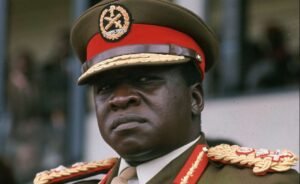This is a list of all the presidents who have served Uganda from 1966 till date, which include their terms in office, and political party:
| President | Term in Office | Political Party |
|---|---|---|
| Edward Mutesa II (Kabaka) | 9 October 1963 - 2 March 1966 | None (Ceremonial President) |
| Milton Obote | 2 March 1966 - 25 January 1971 | Uganda People's Congress (UPC) |
| Idi Amin | 25 January 1971 - 11 April 1979 | Military |
| Yusuf Lule | 11 April 1979 - 20 June 1979 | Independent |
| Godfrey Binaisa | 20 June 1979 - 12 May 1980 | UPC |
| Paulo Muwanga | 12 May 1980 - 30 July 1980 | UPC |
| Bazilio Olara-Okello | 27 July 1985 - 29 July 1985 | Military |
| Tito Okello | 29 July 1985 - 26 January 1986 | Military |
| Yoweri Museveni | 26 January 1986 - Present (Incumbent) | National Resistance Movement (NRM) |
READ ALSO: List Of All Presidents Of Tunisia (1957-Present)
Who Was The First President Of Uganda After Independence?

After gaining independence, the first President of Uganda was Sir Edward Mutesa II, serving from October 9, 1963, until March 2, 1966. Mutesa II was also the Kabaka, or king, of Buganda, one of Uganda’s most important kingdoms.
His presidential election was a big moment that showed Uganda’s move from being a British colony to becoming an independent country. Uganda became independent from British rule on October 9, 1962.
At that time, two major political parties were strong: the Uganda People’s Congress (UPC) and the Kabaka Yekka (KY), which supported the Buganda kingdom.
The UPC, led by Milton Obote, joined forces with the KY to gain power. As part of their deal, Mutesa II became the ceremonial president in 1963, while Obote was the Prime Minister.
Even though Mutesa II was the president, his role was mostly symbolic. The real power was with Obote and the UPC. Over time, tensions between Mutesa II and Obote grew.
They disagreed on how Buganda and the central government should be run. These disagreements led to a major crisis in 1966 when Obote suspended the 1962 constitution.
This ended Mutesa II’s role as president and led to the abolition of traditional kingdoms. Obote then became more authoritarian.
READ ALSO: List Of All Presidents Of Rwanda (1961-Present)
Who Was The President Of Uganda After Amin?

After the fall of Idi Amin in 1979, Uganda went through several leaders before finding some stability. Idi Amin was known for his brutal rule and many human rights abuses.
His regime ended when a group of Ugandan exiles, along with the Tanzanian military, invaded Uganda. This invasion forced Amin to flee and lose power.
The first person to become president after Amin was Yusuf Lule. He took office in April 1979 but only served until June 1979.
Lule was chosen by the Uganda National Liberation Front (UNLF). This group had helped remove Amin from power. However, Lule had difficulty bringing together the different factions that made up the UNLF.
His short time as president ended due to disagreements within the UNLF. After Lule, Godfrey Binaisa became president in June 1979 and stayed in office until May 1980.
Binaisa also faced many problems. He tried to bring stability to the country but struggled with ongoing political conflicts and attempts to consolidate his power.
Milton Obote returned to power in May 1980 after winning a controversial election. This was because Obote had been overthrown by Amin in 1971.
During his second term, Obote faced accusations of election fraud and human rights abuses. His government had to deal with a guerrilla war led by Yoweri Museveni. This conflict eventually led to Obote being overthrown again in January 1986.
READ ALSO: List Of All Prime Ministers Of Canada And Their Parties (1867-Present)
Who Is The Current President Of Uganda?

The current president of Uganda is Yoweri Kaguta Museveni, who has been in office since January 29, 1986. Born on September 15, 1944, Museveni is a well-known Ugandan politician and military officer.
He has been president for the longest time in Uganda’s history. Museveni came to power after leading a military campaign against the government of Milton Obote, which was a big change for Uganda.
Under Museveni’s leadership, Uganda has seen many changes, including economic reforms and infrastructure development.
However, his time in office has also faced criticism. There have been accusations of election fraud and violence, especially in the 2021 presidential election.
In that election, Museveni won with 58.6% of the vote, but the opposition, led by Bobi Wine, claimed the election was unfair.
In 2005, Uganda removed the limit on how many terms a president can serve. This change allowed Museveni to stay in power. In 2017, the age limit for presidential candidates was also removed, making it possible for him to run again.


I love that.
Am updated